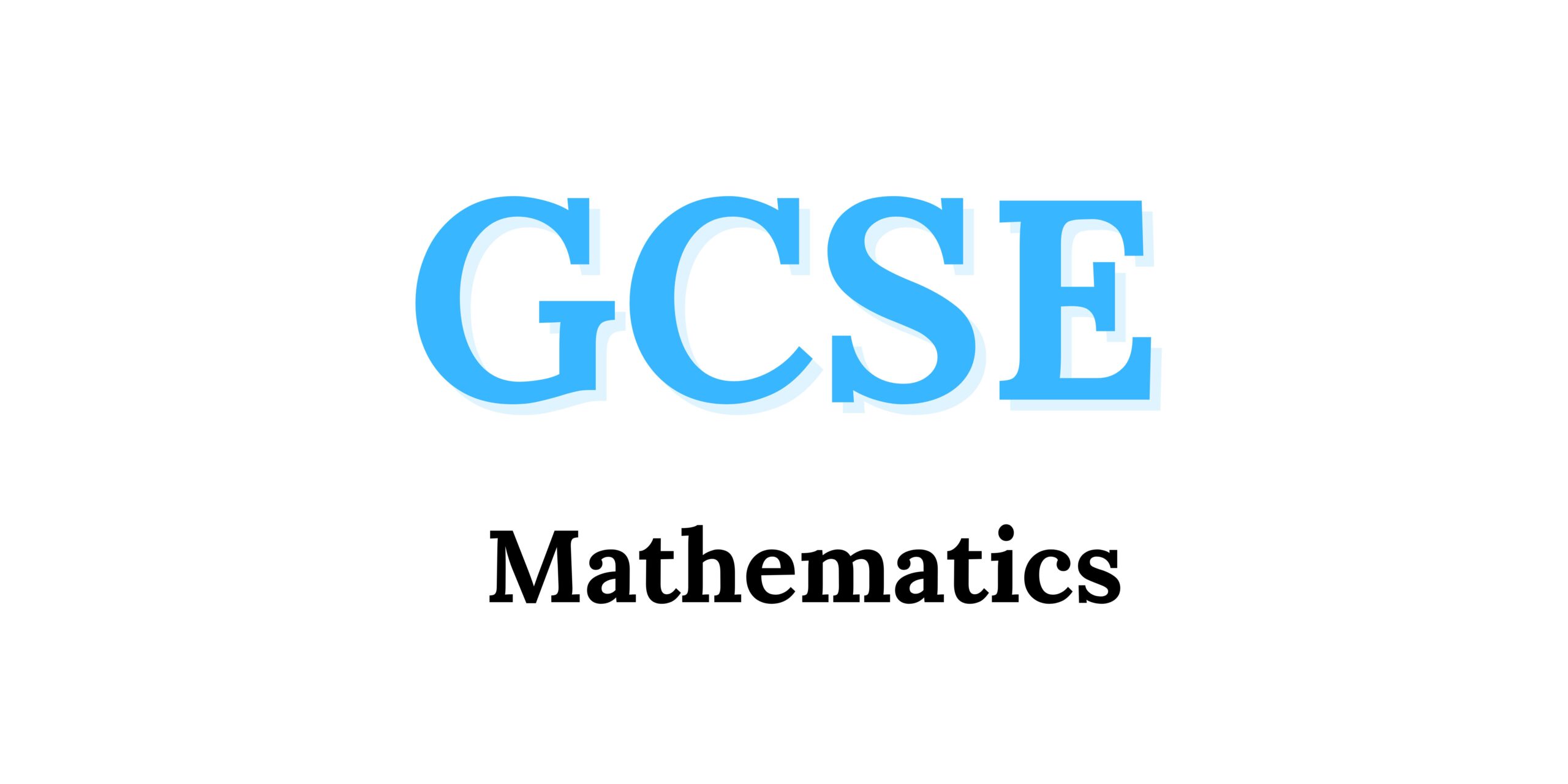
Overview of AQA GCSE Mathematics qualifications
Subject content:
1. Number
| Scope of study | Сontent |
|---|---|
| Structure and calculation | • Compare numbers and apply arithmetic operations. • Understand the digits of numbers and the relationship between operations. • Use standard notation, work with prime numbers, powers, and roots. • Perform calculations with roots, fractional exponents, numbers in the form of π and irrational numbers. • Simplify irrational expressions and use the standard number form A × 10n. |
| Fractions, decimals and percentages | • Convert between terminating decimals and fractions. • Change recurring decimals into fractions and vice versa. • Use fractions in ratio problems. • Interpret fractions and percentages as operators |
| Measures and accuracy | • Use standard units of measurement, including compound measures, with decimals as needed. • Estimate answers and check calculations using approximation and technology. • Round numbers and measures accurately (e.g., decimal places, significant figures). • Use inequality notation to indicate error intervals from rounding or truncation. • Apply and interpret limits of accuracy, including upper and lower bounds. |
2. Algebra
| Scope of study | Сontent |
|---|---|
| Notation, vocabulary and manipulation | • Understand and use notation like ab for a × b, 3y for y + y + y, a2 for a×a, a/b for a÷b, and coefficients as fractions. Use brackets and substitute numerical values into formulae. • Use terms like expressions, equations, formulae, inequalities, terms, factors, and identities. • Simplify expressions by collecting like terms, multiplying terms, factoring out common factors, and applying index laws. Expand and factorise expressions, including quadratic expressions and products of binomials. • Use and rearrange standard formulae, and understand the difference between equations and identities. • Use algebra to argue equivalence and construct proofs. • Interpret expressions as functions, understand inverse functions, and composite functions. |
| Graphs | • Coordinate Systems: Work with coordinates in all four quadrants. • Plot and interpret straight-line graphs using 𝑦=𝑚𝑥+𝑐, identifying parallel and perpendicular lines. Find equations for lines through given points and gradients. • Identify gradients, intercepts, roots, and turning points of linear and quadratic functions graphically and algebraically. Sketch and interpret their graphs, including translations and reflections. • Plot and analyze non-standard graphs, such as reciprocal and exponential graphs, for real-world problems. Calculate gradients and areas under graphs, including distance-time and velocity-time graphs. • Use and find the equation of a circle centered at the origin and determine the equation of a tangent at a given point. |
| Solving equations and inequalities | • Linear Equations: Solve algebraically and graphically, including those with unknowns on both sides. • Quadratic Equations: Solve by factorizing, completing the square, and using the quadratic formula; approximate solutions graphically. • Simultaneous Equations: Solve two linear equations algebraically and graphically; also for linear/quadratic systems. • Numerical Solutions: Use iteration for approximate solutions. • Algebraic Expressions: Convert situations into algebraic expressions, derive and solve equations. • Solve and represent solutions for linear and quadratic inequalities on a number line or graph. |
| Sequences | • Generate terms using term-to-term or position-to-term rules. • Types of Sequences: Recognize and use triangular, square, cube numbers, Fibonacci-type, quadratic, and geometric sequences. • Nth Term: Deduce expressions to calculate the nth term for linear and quadratic sequences. |
3. Ratio, proportion and rates of change
Сontent:
• Units and Conversion: Convert between standard and compound units (e.g., speed, density) in numerical and algebraic contexts.
• Ratios and Proportions: Use ratio notation, simplify ratios, and apply ratios to real-world problems. Express ratios as fractions or percentages and solve problems involving direct and inverse proportion.
• Percentages: Define and interpret percentages, percentage changes, and compare quantities using percentages. Solve problems with percentage increase/decrease, simple interest, and percentages over 100%.
• Rates of Change: Interpret gradients of graphs as rates of change, including average and instantaneous rates. Solve growth and decay problems, including compound interest, and work with iterative processes.
4. Geometry and measures
| Scope of study | Сontent |
|---|---|
| Properties and constructions | • Use standard terms (points, lines, angles, polygons) and label sides/angles of triangles correctly. • Draw diagrams from descriptions and perform ruler/compass constructions (e.g., perpendicular bisectors, angle bisectors). Solve loci problems. • Apply angle properties (e.g., angles on a straight line, alternate/corresponding angles) and derive angle sums in triangles and polygons. • Understand properties of quadrilaterals and triangles. Use triangle congruence criteria (SSS, SAS, ASA, RHS). • Identify and construct congruent/similar shapes, including using rotation, reflection, translation, and enlargement (fractional/negative scale factors). • Apply and prove circle theorems involving angles, radii, tangents, and chords. • Identify properties of 3D shapes (e.g., prisms, cones) and interpret their plans and elevations. |
| Mensuration and calculation | • Use and convert between standard units (length, area, volume, etc.). Measure line segments and angles in figures, including maps and bearings. • Calculate the area of triangles, parallelograms, trapezia, and the volume of cuboids and right prisms (including cylinders). • Know and apply formulas for circumference (2πr, πd) and area (πr²) of circles. Calculate perimeters, areas of circles, composite shapes, and sectors. • Calculate surface area and volume of spheres, pyramids, cones, and composite solids. • Understand relationships between lengths, areas, and volumes in similar figures. • Apply Pythagoras’ theorem (a²+b²=c²) and trigonometric ratios (sin, cos, tan) to find angles and lengths in triangles. • Know exact values of trigonometric functions for key angles (0°, 30°, 45°, 60°, 90°). Use sine and cosine rules to find unknown lengths and angles. • Apply |
| Vectors | • Describe translations using 2D vectors. • Apply addition, subtraction, and scalar multiplication of vectors, using diagrammatic and column representations. • Use vectors to construct geometric arguments and proofs. |
5. Probability
Сontent:
• Record and Analyze: Record and analyze probabilities using tables and frequency trees.
• Expected Outcomes: Calculate expected outcomes considering randomness, fairness, and equal likelihood.
• Probability Properties: Understand that probabilities of exhaustive outcomes or mutually exclusive events sum to 1.
• Empirical vs. Theoretical: Empirical samples tend to match theoretical probabilities as sample size increases.
• Systematic Enumeration: Use tables, grids, Venn diagrams, and tree diagrams to systematically enumerate sets and calculate probabilities.
• Theoretical Possibilities: Construct theoretical possibility spaces for single and combined experiments to calculate probabilities.
• Conditional Probability: Calculate and interpret conditional probabilities using two-way tables, tree diagrams, and Venn diagrams.
6. Statistics
Сontent:
• Sampling: Infer properties of populations from samples, recognizing sampling limitations.
• Data Representation: Construct and interpret tables, charts, and diagrams (e.g., bar charts, pie charts, histograms) for categorical and numerical data, including time series.
• Data Analysis: Compare data distributions using graphical representations and measures of central tendency (median, mean, mode) and spread (range, quartiles, IQR).
• Bivariate Data: Use scatter graphs to recognize correlation, draw lines of best fit, and make predictions while understanding correlation doesn’t imply causation.
For detailed information about the General Certificate of Secondary Education (GCSE) and how it can shape your academic future, click here to explore: GCSE Information
Assessment
Assessment Objectives:
AO1: Apply Standard Techniques:
– Recall facts, terminology, and definitions accurately.
– Use notation correctly and carry out multi-step solutions effectively.
AO2: Reason and Communicate Mathematically:
– Make deductions and draw conclusions.
– Build logical reasoning, communicate accurately, and present arguments and proofs.
– Assess the validity of arguments and presentations.
AO3: Solve Problems in Various Contexts:
– Translate problems into mathematical processes.
– Connect different math concepts, interpret results, and evaluate methods and solutions, considering assumptions.
| Type of assessment | Content | Final score | Weighting of final grade |
|---|---|---|---|
| Paper 1 (non-calculator): A mix of question styles, from short, single-mark questions to multi-step problems. The mathematical demand increases as a student progresses through the paper | Content from any part of the specification may be assessed | 80 marks | 33⅓% |
| Paper 2 (calculator): A mix of question styles, from short, single-mark questions to multi-step problems. The mathematical demand increases as a student progresses through the paper | Content from any part of the specification may be assessed | 80 marks | 33⅓% |
| Paper 3 (calculator): A mix of question styles, from short, single-mark questions to multi-step problems. The mathematical demand increases as a student progresses through the paper | Content from any part of the specification may be assessed | 80 marks | 33⅓% |
Assessment objective weightings for GCSE Mathematics
Foundation tier
| Assessment objectives (AOs)* | Component weightings Paper 1 (%) | Component weightings Paper 2 (%) | Component weightings Paper 3 (%) | Overall weighting (approx %) |
|---|---|---|---|---|
| AO1 | 40-60 | 40-60 | 40-60 | 50 |
| AO2 | 15-35 | 15-35 | 15-35 | 25 |
| AO3 | 15-35 | 15-35 | 15-35 | 25 |
| Overall weighting of components | 33⅓ | 33⅓ | 33⅓ | 100 |
Higher tier
| Assessment objectives (AOs)* | Component weightings Paper 1 (%) | Component weightings Paper 2 (%) | Component weightings Paper 3 (%) | Overall weighting (approx %) |
|---|---|---|---|---|
| AO1 | 30-50 | 30-50 | 30-50 | 40 |
| AO2 | 20-40 | 20-40 | 20-40 | 30 |
| AO3 | 20-40 | 20-40 | 20-40 | 30 |
| Overall weighting of components | 33⅓ | 33⅓ | 33⅓ | 100 |
Assessment weightings
The marks on the papers will be scaled according to the weighting of each component. Students’ final marks will be the sum of these scaled marks. Grade boundaries will be determined based on this total scaled mark. The scaling and total scaled marks are detailed in the table below.
| Component | Maximum raw mark | Scaling factor | Maximum scaled mark |
|---|---|---|---|
| Paper 1 | 80 | x1 | 80 |
| Paper 2 | 80 | x1 | 80 |
| Paper 3 | 80 | x1 | 80 |
| Total scaled mark: | 240 |
If you need help with Mathematics or any other subject, our tutors are ready to support you on your academic journey. Don’t miss your chance to succeed—take a trial lesson today!











